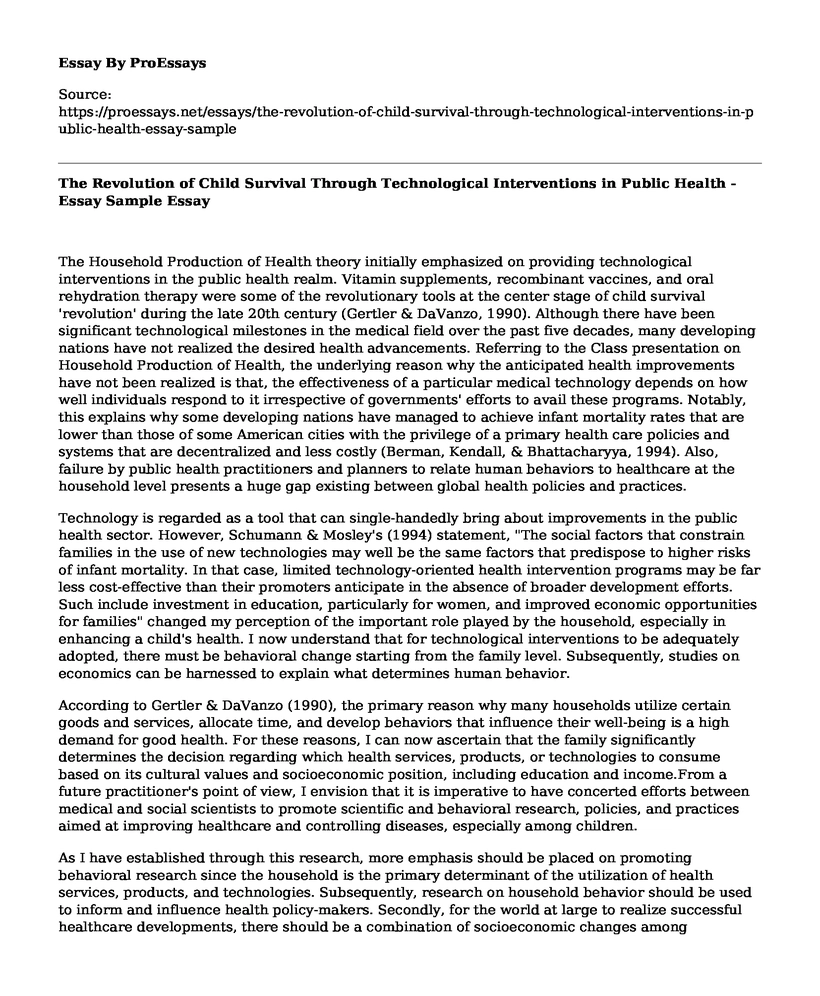The Household Production of Health theory initially emphasized on providing technological interventions in the public health realm. Vitamin supplements, recombinant vaccines, and oral rehydration therapy were some of the revolutionary tools at the center stage of child survival 'revolution' during the late 20th century (Gertler & DaVanzo, 1990). Although there have been significant technological milestones in the medical field over the past five decades, many developing nations have not realized the desired health advancements. Referring to the Class presentation on Household Production of Health, the underlying reason why the anticipated health improvements have not been realized is that, the effectiveness of a particular medical technology depends on how well individuals respond to it irrespective of governments' efforts to avail these programs. Notably, this explains why some developing nations have managed to achieve infant mortality rates that are lower than those of some American cities with the privilege of a primary health care policies and systems that are decentralized and less costly (Berman, Kendall, & Bhattacharyya, 1994). Also, failure by public health practitioners and planners to relate human behaviors to healthcare at the household level presents a huge gap existing between global health policies and practices.
Technology is regarded as a tool that can single-handedly bring about improvements in the public health sector. However, Schumann & Mosley's (1994) statement, "The social factors that constrain families in the use of new technologies may well be the same factors that predispose to higher risks of infant mortality. In that case, limited technology-oriented health intervention programs may be far less cost-effective than their promoters anticipate in the absence of broader development efforts. Such include investment in education, particularly for women, and improved economic opportunities for families" changed my perception of the important role played by the household, especially in enhancing a child's health. I now understand that for technological interventions to be adequately adopted, there must be behavioral change starting from the family level. Subsequently, studies on economics can be harnessed to explain what determines human behavior.
According to Gertler & DaVanzo (1990), the primary reason why many households utilize certain goods and services, allocate time, and develop behaviors that influence their well-being is a high demand for good health. For these reasons, I can now ascertain that the family significantly determines the decision regarding which health services, products, or technologies to consume based on its cultural values and socioeconomic position, including education and income.From a future practitioner's point of view, I envision that it is imperative to have concerted efforts between medical and social scientists to promote scientific and behavioral research, policies, and practices aimed at improving healthcare and controlling diseases, especially among children.
As I have established through this research, more emphasis should be placed on promoting behavioral research since the household is the primary determinant of the utilization of health services, products, and technologies. Subsequently, research on household behavior should be used to inform and influence health policy-makers. Secondly, for the world at large to realize successful healthcare developments, there should be a combination of socioeconomic changes among communities and households, comprehensive healthcare delivery strategies, and suitable technologies. Also, developing clinically functional health technologies is not the ultimate solution to improved healthcare. On the contrary, realizing the maximum potential of these health technologies requires that they are used correctly and consistently at household levels.
References
Berman, P., Kendall, C., & Bhattacharyya, K. (1994). The household production of health: integrating social science perspectives on micro-level health determinants. Social Science and Medicine, 38(2), 205-216. https://www.researchgate.net/publication/227422840_The_household_production_of_health_Integrating_social_science_perspectives_on_micro-level_health_determinants
DaVanzo, J., & Gertler, P. (1990). Household production of health: A microeconomic perspective on health transitions. Rand Corporation. https://www.rand.org/content/dam/rand/pubs/notes/2009/N3014.pdf
Schumann, D. A., & Mosley, W. H. (1994). The household production of health: Introduction. Social Science & Medicine, 38(2), 201-204. https://www.sciencedirect.com/sdfe/pdf/download/eid/1-s2.0-0277953694903891/first-page-pdf
Cite this page
The Revolution of Child Survival Through Technological Interventions in Public Health - Essay Sample. (2023, May 07). Retrieved from https://proessays.net/essays/the-revolution-of-child-survival-through-technological-interventions-in-public-health-essay-sample
If you are the original author of this essay and no longer wish to have it published on the ProEssays website, please click below to request its removal:
- Level of Education of the Nurse Paper Example
- Regulation of Fake Drugs Paper Example
- Evidence-Based Obesity Prevention in Childhood Essay Example
- Essay Sample on Matrix Care Application
- Hospitals Reduce Cost of Care Through Improved Discharge Periods - Research Paper
- Paper Example on Entrusting My Teeth to Doctor: Trust & Understanding
- Essay Example on Obesity: a Serious Disease with Severe Health Risks







